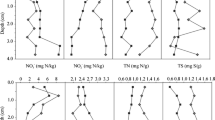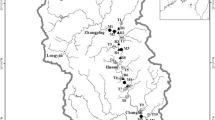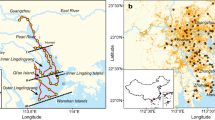Abstract
Accurate estimation and control of greenhouse gas emissions have been recognized as imperative in recent years. Therefore, frequent investigations under uniform environmental conditions are required to better understand this concept. Thus, six sampling sites with characteristic concentrations of nitrogen and other water quality parameters were selected to investigate the behavior of water quality parameters throughout the year and to statistically examine the correlations among the parameters. Dissolved nitrous oxide (D-N2O) showed the highest positive correlation coefficient with NO2-N among nitrogen species. The results of the principal component analysis suggested that river water quality could be broadly classified based on photosynthesis and contamination from treated wastewater. Photosynthesis caused an increase in pH, with concomitant decrease in D-N2O concentration. Using the results of multiple regression analysis, D-N2O was accurately estimated based on nitrogen concentration, pH, and concentration of organic matter in various situations. The results of a detailed survey suggested that D-N2O was produced in the river from nitrogen sources released from the wastewater treatment plant. The main roles of the wastewater treatment plant for D-N2O behavior in the river were the supply of the nitrogen source that was the precursor of D-N2O, the supply of the nutrients that induced the photosynthesis, and the direct supply of D-N2O at a low water temperature. The models based on multiple regression analysis could efficiently predict the D-N2O concentration produced in rivers at sites downstream of the wastewater treatment plant, except for the direct supply of D-N2O as an effluent at low water temperature.





Similar content being viewed by others

References
Baulch, H. M., Dillon, P. J., Maranger, R., Venkiteswaran, J. J., Wilson, H. F., & Schiff, S. L. (2012). Night and day: short-term variation in nitrogen chemistry and nitrous oxide emissions from streams. Freshwater Biology, 57, 509–525.
Beaulieu, J. J., Arango, C. P., Hamilton, S. K., & Tank, J. L. (2008). The production and emission of nitrous oxide from headwater streams in the Midwestern United States. Global Change Biology, 14(4), 878–894.
Clough, T. J., Bertram, J. E., Sherlock, R. R., Leonard, R. L., & Nowicki, B. L. (2006). Comparison of measured and EF5-r-derived N2O fluxes from a spring-fed river. Global Change Biology, 12(2), 352–363.
Clough, T. J., Buckthought, L. E., Kelliher, F. M., & Sherlock, R. R. (2007). Diurnal fluctuations of dissolved nitrous oxide (N2O) concentrations and estimates of N2O emissions from a spring-fed river: implications for IPCC methodology. Global Change Biology, 13(5), 1016–1027.
Garnier, J., Cebron, A., Tallec, G., Billen, G., Sebilo, M., & Martinez, A. (2006). Nitrogen behaviour and nitrous oxide emission in the tidal Seine river estuary (France) as influenced by human activities in the upstream watershed. Biogeochemistry, 77, 305–326.
Harrison, J. A., Matson, P. A., & Fendorf, S. E. (2005). Effects of a diel oxygen cycle on nitrogen transformations and greenhouse gas emissions in a eutrophied subtropical stream. Aquatic Sciences, 67, 308–315.
Hinshaw, S. E., & Dahlgren, R. A. (2013). Dissolved nitrous oxide concentrations and fluxes from the eutrophic San Joaquin River, California. Environmental Science and Technology, 47(3), 1313–1322.
Hiscock, K. M., Bateman, A. S., Mühlherr, I. H., Fukada, T., & Dennis, P. F. (2003). Indirect emissions of nitrous oxide from regional aquifers in the United Kingdom. Environmental Science and Technology, 37(16), 3507–3512.
Hu, M., Chen, D., & Dahlgren, R. A. (2016). Modeling nitrous oxide emission from rivers: a global assessment. Global Change Biology, 22(11), 1–17.
IPCC (2006). 2006 IPCC guidelines for national greenhouse gas inventories.
IPCC (2013). Climate change 2013 – the physical science basis.
IPCC (2019). 2019 refinement to the 2006 IPCC guidelines for national greenhouse gas inventories.
Kampschreur, M. J., Temmink, H., Kleerebezem, R., Jetten, M. S. M., & van Loosdrecht, M. C. M. (2009). Nitrous oxide emission during wastewater treatment. Water Research., 43, 4093–4103.
Kool, D. M., Wrage, N., Oenema, O., Dolfing, J., & Groenigen, J. W. V. (2007). Oxygen exchange between (de)nitrification intermediates and H2O and its implications for source determination of NO3- and N2O: a review. Rapid Communications in Mass Spectrometry, 21, 3569–3578.
Li, S. -L., Liu, C. -Q., Li, J., Liu, X., Chetelat, B., Wang, B., & Wang, F. (2010). Assessment of the sources of nitrate in the Changjiang River, China using a nitrogen and oxygen isotopic approach. Environmental Science and Technology, 44(5), 1573–1578.
Liu, X. -L., Bai, L., Wang, Z. -L., Li, J., Yue, F. -J., & Li, S. -L. (2015). Nitrous oxide emissions from river network with variable nitrogen loading in Tianjin, China. Journal of Geochemical Exploration, 157, 153–161.
Massara, T. M., Malamis, S., Guisasola, A., Baeza, J., Noutsopoulos, C., & Katsou, E. (2017). A review on nitrous oxide (N2O) emissions during biological nutrient removal from municipal wastewater and sludge reject water. Sci. Total Environ., 596-597, 106–123.
Masuda, S., Otomo, S., Maruo, C., & Nishimura, O. (2018). Contribution of dissolved N2O in total N2O emission from sewage treatment plant. Chemosphere, 212, 821–827.
McMahon, P. B., & Dennehy, K. F. (1999). N2O emissions from a nitrogen-enriched river. Environmental Science and Technology, 33(1), 21–25.
Mosier, A.R., Kroeze, C., Nevison, C., Oenema, O., Seitzinger, S., van Cleemput, O. (1998). Closing the global N2O budget: nitrous oxide emissions through the agricultural nitrogen cycle. Nutrient Cycling in Agroecosystems, 52(2), 225–248.
Nevison, C. (2000). Review of the IPCC methodology for estimating nitrous oxide emissions associated with agricultural leaching and runoff. Chemosphere - Global Change Science, 2, 493–500.
Pang, J., Yamato, M., Soda, S., Inoue, D., & Ike, M. (2019). Nitrogen-cycling functional genes in brackish and freshwater sediments in Yodo river in Japan. Journal of Water and Environment Technology, 17(2), 109–116.
Ravishankara, A. R., Daniel, J. S., & Portmann, R. W. (2009). Nitrous oxide (N2O): the dominant ozone-depleting substance emitted in the 21st century. Science, 326, 123–125.
Reay, D. S., Smith, K. A., & Edwards, A. C. (2004). Nitrous oxide in agricultural drainage waters following field fertilization. Water Air Soil Pollution: Focus, 4, 437–451.
Reay, D., Smith, K. A., Edwards, A. C., Hiscock, K. M., Dong, L. F., & Nedwell, D. (2005). Indirect nitrous oxide emissions: revised emission factors. Environ. Sciences, 2, 153–158.
Rosamond, M. S., Thuss, S. J., Schiff, S. L., & Elgood, R. J. (2011). Coupled cycles of dissolved oxygen and nitrous oxide in rivers along a trophic gradient in Southern Ontario, Canada. Journal of Environmental Qualities, 40, 256–270.
Sawamoto, T., Nakajima, Y., Kasuya, M., Tsuruta, H., & Yagi, K. (2005). Evaluation of emission factors for indirect N2O emission due to nitrogen leaching in agro-ecosystems. Geophysical Research Letters, 32(3), 1–4.
Stevens, R. J., Laughlin, R. J., & Malone, J. P. (1998). Soil pH affects the processes reducing nitrate to nitrous oxide and di-nitrogen. Soil Biology and Biochemistry, 30(8–9), 1119–1126.
Thörn, M., & Sörensson, F. (1996). Variation of nitrous oxide formation in the denitrification basin in a wastewater treatment plant with nitrogen removal. Water research, 30(6), 1543–1547.
Wang, J., Chen, N., Yan, W., Wang, B., & Yang, L. (2015). Effect of dissolved oxygen and nitrogen on emission of N2O from rivers in China. Atmospheric Environment, 103, 347–356.
Weiss, R. F., & Price, B. A. (1980). Nitrous oxide solubility in water and seawater. Marine Chemistry, 8, 347–359.
Acknowledgments
We would like to express our gratitude to all those who contributed to this work.
Funding
This work was supported by JSPS KAKENHI Grant Number JP15K14060.
Author information
Authors and Affiliations
Corresponding author
Additional information
Publisher’s note
Springer Nature remains neutral with regard to jurisdictional claims in published maps and institutional affiliations.
Supplementary information
ESM 1
(PDF 266 kb)
Rights and permissions
About this article
Cite this article
Mishima, I., Masuda, S., Kakimoto, T. et al. Assessment of nitrous oxide production in eutrophicated rivers with inflow of treated wastewater based on investigation and statistical analysis. Environ Monit Assess 193, 93 (2021). https://doi.org/10.1007/s10661-021-08855-z
Received:
Accepted:
Published:
DOI: https://doi.org/10.1007/s10661-021-08855-z



